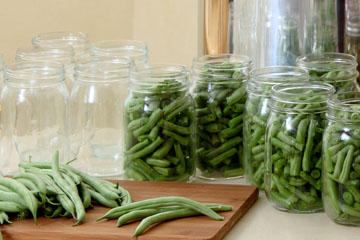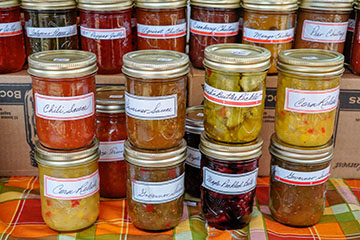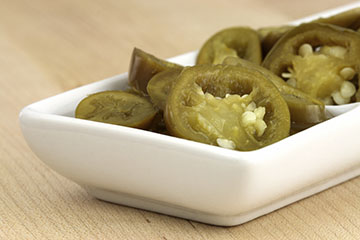
Avoid Dangerous Canning Methods

Interest in home gardening has skyrocketed, prompting many people to try home canning for the first time. Due to increased demand, canning equipment is difficult to find. Extension centers are being bombarded with requests for alternative canning methods. So let’s set the facts straight — the following unsafe methods are not recommended!
- Reusing canning lids (flats). Used lids greatly increase the risk of failed jar seals. Why? Used canning lids generally are warped, so they will not fit the canning jar rims correctly. Therefore, the lid’s compromised sealing compound may not seal properly.
- Open-kettle canning (or the inversion method). The food is prepared, heated, packed into hot jars and sealed without heat processing then the jar is turned upside down to cool. While the jar may seal, the food may have been exposed to airborne bacteria just before sealing. Once jars are filled, the contents start cooling, so airborne bacteria contacting the cooling surfaces will still be viable. A variation of this involves setting filled jars outside in the sun for days. Both of these methods give insufficient heat to destroy bacteria that could lead to spoilage or foodborne illness.
- Microwave canning. Microwave ovens are for meal preparation, not home canning. A microwave oven heats food unevenly and likely will not get all of a jar’s contents hot enough for the length of time required for safe canning. Jars may explode as they are heated or when they are removed from the oven. Metal lids and rings may cause electrical sparks.
- Oven canning. Oven canning can be very dangerous. The oven canning method involves placing jars in a hot oven for a long period of time, though product temperatures never exceed the boiling point because of the dry heat. It is unsafe for both high-acid and low-acid products — including meats and most vegetables — which require temperatures of 212 degree F and above for safe canning. Heat transfer through jars is much slower with oven dry heat than in a water bath or a pressurized steam canner. This greatly increases the risk of spoilage, or worse, survival of Clostridium botulinum spores, the source of deadly botulism poisoning. Canning jar glass is not designed to withstand an oven’s intense dry heat, and the glass may shatter.
- Dishwasher canning. Processing jars of food in the dishwasher is dangerous because its water temperature is too low to kill harmful microorganisms. Your food will be underprocessed and unsafe to eat.
- Reusing mayonnaise or other food glass jars. Repurposed commercial food jars may well break, especially if they’re used in a pressure canner. The standard two-piece canning lid and ring also may not fit jar mouths safely.
- Paraffin wax on sweet spreads. Paraffin wax may allow mold to grow, or may catch fire if overheated during preparation. All sweet spreads must be water bath canned for safety.
- Aspirin preservation. Adding aspirin tablets to any canned food is not a substitute for water bath or pressure canning! It is extremely dangerous.
Sources: National Center for Home Food Preservation. n.d. “Frequently Asked Canning Questions.”
Can I Sell My Canned Foods?

Prolific canners may be interested in earning extra income by selling their canned foods may be interested in earning extra income by selling canned foods.
In some cases, it is legal to sell food canned at home — but in other cases, it is not. In Kansas and Missouri, any canned goods sold to grocery stores or other distributors as well as products sold across state lines require a food processor’s license and cannot be produced in a regular home kitchen.
Within Kansas, fruit jams and jellies with regular levels of sugar and canned fruits sold directly to consumers — such as in a farmers market or via an online transaction within state lines — do not require a license and can be made in a home kitchen. Food sales across state lines and the sale of other canned products, such as sauerkraut, pickles, canned vegetables and most salsas, do require a license and so cannot be made in a regular home kitchen.
These product sales also require the processor to attend Better Process Control School, available online and in Columbia, Missouri, in late March 2021 (pandemic permitting).
The regulations are similar in Missouri, as jams and jellies with regular levels of sugar made by smaller processors likewise do not require licensing for sales and can be made at home. Other canned products, such as pickles, canned vegetables and canned meats, require a license and cannot be produced in a regular home kitchen. In Missouri, always check with your local public health inspector before preparing any food for sale, as regulations may vary in different localities.
More information on Kansas regulations for selling canned foods directly to consumers can be found in “Food Safety for Kansas Farmers Market Vendors: Regulations and Best Practices.” Missouri regulations can be found in the “Regulations for Selling Safe Canned Foods in Missouri Fact Sheet.”
Maple Pickled Jalapeño

Yield: 4 pint jars
Ingredients:
- 2½–3 pounds firm jalapeños, sliced into ¼-inch rounds
- 1 red onion, quartered and thinly sliced
- 1 cup maple syrup
- 1 cup sugar
- 3 cups apple cider vinegar
- 1½ cups water
- 3 teaspoons salt
- 2 teaspoons mustard seeds
- 2 teaspoons black peppercorns
Instructions:
- Prepare the boiling water or steam canner.
- Heat your canning jars in simmering water until you’re ready to use them; do not boil. Wash the lids in warm soapy water and set them aside with their bands.
- Combine maple syrup, sugar, vinegar, water and all the seasonings in a nonreactive pot and bring the mixture to a simmer for 5 minutes.
- Add the jalapeño and onion slices, and simmer another 5 minutes.
- Ladle hot jalapeños and onions into a hot jar, leaving a ½-inch headspace; top off with more brine, if necessary.
- Remove air bubbles. Wipe the jar rim. Center the lid on the jar and apply the band, adjusting to fingertip-tight. Place the jar in boiling water or a steam canner. Repeat until all the jars are filled.
- Process the jars for 15 minutes, adjusting for altitude. Turn off the heat, remove the lid and let the jars stand for 5 minutes. Remove the jars and cool for 12–24 hours.
Sources: Fresh Preserving. n.d. “Maple Pickled Jalapeño.”